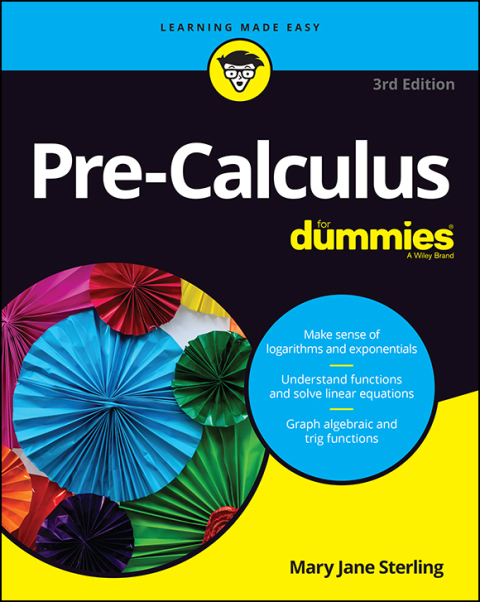Description
Efnisyfirlit
- Cover
- Introduction
- About This Book
- Foolish Assumptions
- Icons Used in This Book
- Beyond the Book
- Where to Go from Here
- Part 1: Getting Started with Pre-Calculus
- Chapter 1: Pre-Pre-Calculus
- Pre-Calculus: An Overview
- All the Number Basics (No, Not How to Count Them!)
- Visual Statements: When Math Follows Form with Function
- Get Yourself a Graphing Calculator
- Chapter 2: Playing with Real Numbers
- Solving Inequalities
- Variations on Dividing and Multiplying: Working with Radicals and Exponents
- Chapter 3: The Building Blocks of Pre-Calculus Functions
- Qualities of Special Function Types and Their Graphs
- Dealing with Parent Functions and Their Graphs
- Graphing Functions That Have More Than One Rule: Piece-Wise Functions
- Setting the Stage for Rational Functions
- Putting the Results to Work: Graphing Rational Functions
- Chapter 4: Operating on Functions
- Transforming the Parent Graphs
- Sharpen Your Scalpel: Operating on Functions
- Turning Inside Out with Inverse Functions
- Chapter 5: Digging Out and Using Roots to Graph Polynomial Functions
- Understanding Degrees and Roots
- Factoring a Polynomial Expression
- Finding the Roots of a Factored Equation
- Cracking a Quadratic Equation When It Won’t Factor
- Solving Unfactorable Polynomials with a Degree Higher Than Two
- Put It in Reverse: Using Solutions to Find Factors
- Graphing Polynomials
- Chapter 6: Exponential and Logarithmic Functions
- Exploring Exponential Functions
- Logarithms: The Inverse of Exponential Functions
- Base Jumping to Simplify and Solve Equations
- Growing Exponentially: Word Problems in the Kitchen
- Part 2: The Essentials of Trigonometry
- Chapter 7: Circling in on Angles
- Introducing Radians: Circles Weren’t Always Measured in Degrees
- Trig Ratios: Taking Right Triangles a Step Further
- Understanding How Trig Ratios Work on the Coordinate Plane
- Building the Unit Circle by Dissecting the Right Way
- Digesting Special Triangle Ratios
- Triangles and the Unit Circle: Working Together for the Common Good
- Measuring Arcs: When the Circle Is Put in Motion
- Chapter 8: Simplifying the Graphing and Transformation of Trig Functions
- Drafting the Sine and Cosine Parent Graphs
- Graphing Tangent and Cotangent
- Putting Secant and Cosecant in Pictures
- Transforming Trig Graphs
- Chapter 9: Identifying with Trig Identities: The Basics
- Keeping the End in Mind: A Quick Primer on Identities
- Lining Up the Means to the End: Basic Trig Identities
- Tackling Difficult Trig Proofs: Some Techniques to Know
- Chapter 10: Advanced Identities: Your Keys to Success
- Finding Trig Functions of Sums and Differences
- Doubling an Angle and Finding Its Trig Value
- Taking Trig Functions of Common Angles Divided in Two
- A Glimpse of Calculus: Traveling from Products to Sums and Back
- Eliminating Exponents with Power-Reducing Formulas
- Chapter 11: Taking Charge of Oblique Triangles with the Laws of Sines and Cosines
- Solving a Triangle with the Law of Sines
- Conquering a Triangle with the Law of Cosines
- Filling in the Triangle by Calculating Area
- Part 3: Analytic Geometry and System Solving
- Chapter 12: Plane Thinking: Complex Numbers and Polar Coordinates
- Understanding Real versus Imaginary
- Combining Real and Imaginary: The Complex Number System
- Graphing Complex Numbers
- Plotting Around a Pole: Polar Coordinates
- Chapter 13: Creating Conics by Slicing Cones
- Cone to Cone: Identifying the Four Conic Sections
- Going Round and Round: Graphing Circles
- Riding the Ups and Downs with Parabolas
- The Fat and the Skinny on the Ellipse
- Pair Two Curves and What Do You Get? Hyperbolas
- Expressing Conics Outside the Realm of Cartesian Coordinates
- Chapter 14: Streamlining Systems, Managing Variables
- A Primer on Your System-Solving Options
- Algebraic Solutions of Two-Equation Systems
- Solving Systems with More than Two Equations
- Decomposing Partial Fractions
- Surveying Systems of Inequalities
- Introducing Matrices: The Basics
- Simplifying Matrices to Ease the Solving Process
- Making Matrices Work for You
- Chapter 15: Sequences, Series, and Expanding Binomials for the Real World
- Speaking Sequentially: Grasping the General Method
- Difference between Terms: Arithmetic Sequences
- Ratios and Consecutive Paired Terms: Geometric Sequences
- Creating a Series: Summing Terms of a Sequence
- Expanding with the Binomial Theorem
- Chapter 16: Onward to Calculus
- Scoping Out the Differences between Pre-Calculus and Calculus
- Understanding Your Limits
- Finding the Limit of a Function
- Operating on Limits: The Limit Laws
- Calculating the Average Rate of Change
- Exploring Continuity in Functions
- Part 4: The Part of Tens
- Chapter 17: Ten Polar Graphs
- Spiraling Outward
- Falling in Love with a Cardioid
- Cardioids and Lima Beans
- Leaning Lemniscates
- Lacing through Lemniscates
- Roses with Even Petals
- A Rose Is a Rose Is a Rose
- Limaçon or Escargot?
- Limaçon on the Side
- Bifolium or Rabbit Ears?
- Chapter 18: Ten Habits to Adjust before Calculus
- Figure Out What the Problem Is Asking
- Draw Pictures (the More the Better)
- Plan Your Attack — Identify Your Targets
- Write Down Any Formulas
- Show Each Step of Your Work
- Know When to Quit
- Check Your Answers
- Practice Plenty of Problems
- Keep Track of the Order of Operations
- Use Caution When Dealing with Fractions
- Index
- About the Author
- Advertisement Page
- Connect with Dummies
- End User License Agreement






Reviews
There are no reviews yet.